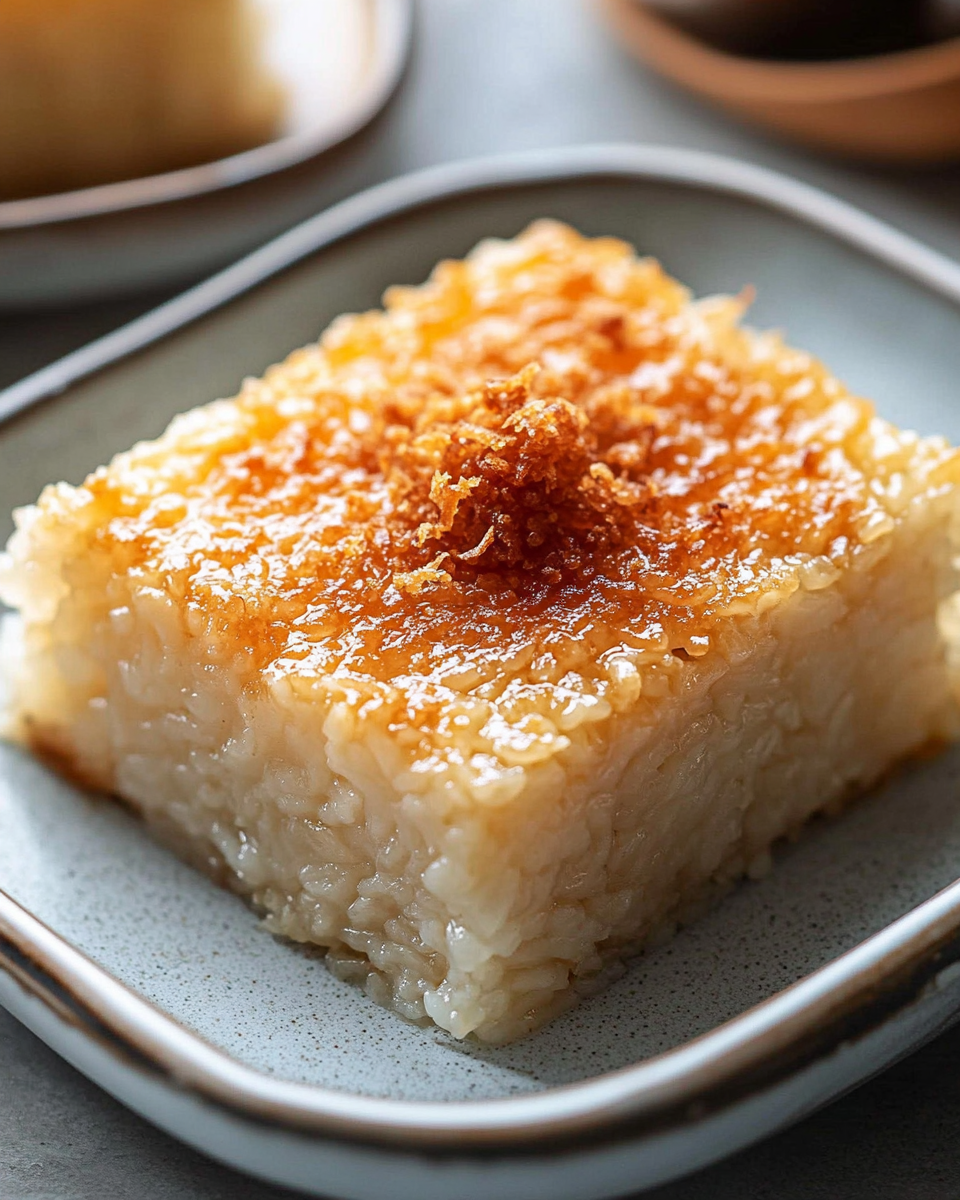Biko is a popular Filipino dessert made from sticky rice, coconut milk, and brown sugar. It has a rich, sweet flavor and a chewy texture that makes it a perfect treat for special occasions or as a snack. This traditional dish is often topped with caramelized coconut milk to add extra sweetness.
FULL RECIPE
Ingredients
- 2 cups glutinous rice (sweet rice)
- 4 cups coconut milk
- 1 ½ cups brown sugar (packed)
- ½ teaspoon salt
- 1 tablespoon vanilla extract (optional)
- 1 tablespoon butter (optional, for greasing)
Directions
- Rinse the glutinous rice in cold water until the water runs clear. Drain the rice.
- In a large pot, combine the rinsed rice with 4 cups of coconut milk. Bring it to a boil over medium heat.
- Once boiling, lower the heat and simmer for about 20-25 minutes, stirring occasionally until the rice is tender and most of the coconut milk is absorbed.
- Stir in the brown sugar and salt. Continue to cook, stirring constantly, for about 10-15 minutes or until the mixture becomes thick and sticky.
- Optionally, add vanilla extract and butter for extra flavor and creaminess, stirring until fully incorporated.
- Grease a baking dish with butter or cooking spray. Transfer the cooked rice mixture into the prepared dish and spread it evenly.
- Let it cool completely at room temperature, then refrigerate for a few hours or overnight to set before serving.
Nutritional Information
- Serving size: 1 piece (approximately 2-inch square)
- Calories: 200-250
- Carbohydrates: 40-45g
- Protein: 2-3g
- Fat: 5-7g
- Fiber: 1g
- Sugar: 20-25g
History of Biko
Biko is a traditional Filipino dessert with a rich history that dates back to ancient times. Its roots lie in the use of glutinous rice, which is a staple in Southeast Asia. In the Philippines, glutinous rice was considered sacred and used in various ceremonies. Over time, this sticky rice evolved into a sweet dessert, combining coconut milk and sugar to create the beloved treat we know today. Its popularity grew during fiestas and special occasions, making it a staple dessert during holidays like Christmas and New Year.
Cultural Significance
In Filipino culture, food plays an essential role in social gatherings and celebrations, and Biko is no exception. It is often served during family gatherings, birthdays, and other festive events. The sweet and sticky nature of Biko symbolizes togetherness and unity. Sharing a plate of Biko signifies a communal spirit, as family and friends gather around to enjoy this delicious treat together. It also serves as a reminder of the Philippines’ agricultural heritage, where rice is a symbol of prosperity.
Ingredients in Biko
The main ingredients of Biko are glutinous rice, coconut milk, and brown sugar. Glutinous rice is the foundation of this dessert, providing its sticky and chewy texture. Coconut milk adds a rich, creamy flavor that complements the sweetness of the brown sugar. The brown sugar not only adds sweetness but also gives the dish its distinct caramelized flavor when cooked together with the coconut milk. These simple ingredients come together to create a dessert that is beloved across generations in the Philippines.
Variations of Biko
While the classic Biko recipe remains unchanged, there are numerous regional variations throughout the Philippines. In some regions, Biko is topped with latik, which is made by simmering coconut milk until it thickens and forms golden brown curds. Other variations might include the addition of different fruits, such as jackfruit or coconut meat, to enhance the flavor. Some families may even add a hint of pandan or vanilla extract to give the dish an aromatic twist. These variations reflect the creativity and adaptability of Filipino cooking, where local ingredients are often used to personalize traditional recipes.
Cooking Techniques for Biko
The key to making perfect Biko lies in the cooking technique. It is important to cook the rice slowly over a low heat to allow it to absorb the coconut milk completely. This ensures that the rice becomes tender and sticky, creating the ideal texture for the dish. The sugar and coconut milk should be simmered carefully to prevent burning or crystallization. Stirring constantly is crucial during the sugar caramelization process to achieve the right balance of sweetness without burning the mixture.
Serving Biko
Biko is typically served at room temperature or chilled. After it has been cooked and allowed to cool, it is cut into square or diamond-shaped pieces. It can be served as a dessert or as a sweet snack during tea time. When serving Biko, it is common to present it in a large platter for everyone to share, allowing family and friends to enjoy it together. Some people also serve it with a sprinkle of toasted coconut on top for added flavor and texture.
Biko and Special Occasions
Biko is a dessert that holds a special place in Filipino culture, particularly during major holidays and celebrations. It is often prepared in large batches to cater to the needs of a big family or group of friends. During Christmas and New Year, Biko is one of the many dishes served as part of the Noche Buena (Christmas Eve feast) or Media Noche (New Year’s Eve feast). The dish is also a favorite during birthdays, weddings, and baptisms, adding sweetness to these joyful events.
Nutritional Benefits of Biko
Although Biko is a sweet dessert, it contains some nutritional benefits. Glutinous rice provides carbohydrates, which are a source of energy. Coconut milk is rich in healthy fats, particularly medium-chain triglycerides (MCTs), which can support brain function and energy metabolism. The brown sugar used in Biko contains trace amounts of minerals like iron, calcium, and potassium, though it is still a high-calorie ingredient. Biko is best enjoyed in moderation as part of a balanced diet.
Popular Pairings with Biko
Biko can be paired with a variety of beverages to enhance the dining experience. It is commonly enjoyed with hot drinks like coffee or tea, as the sweetness of Biko complements the bitterness of these beverages. For a more refreshing contrast, Biko can also be served with fresh fruit juices, such as calamansi or mango. In some regions of the Philippines, Biko is even enjoyed with a cold glass of sago’t gulaman, a sweet beverage made with tapioca pearls and agar jelly.
Biko and Filipino Hospitality
Filipinos are known for their hospitality, and Biko plays a significant role in this tradition. When guests visit a Filipino household, it is common for the host to serve them food, and Biko is often among the treats offered. It symbolizes the warmth and generosity of Filipino culture, where food is shared as a gesture of welcome and care. Offering a plate of Biko to visitors is seen as a way of making them feel at home and valued.
Making Biko for Large Gatherings
If you’re preparing Biko for a large gathering, it’s important to scale up the recipe to ensure there’s enough for everyone. The recipe can be doubled or tripled depending on the number of guests. To do this effectively, you may need to adjust the cooking time, as larger quantities of rice and coconut milk will take longer to cook. Be sure to use a large pot to prevent spilling and stir the mixture regularly to ensure it cooks evenly.
Storing Biko
Biko can be stored in an airtight container at room temperature for up to three days. If you want to keep it fresh for a longer period, you can refrigerate it for up to a week. Biko can also be frozen for up to a month if properly wrapped. To reheat, simply microwave individual servings or warm it up in the oven. However, note that the texture may change slightly after refrigeration or freezing.
Biko as a Gift
Biko is often given as a gift during special occasions. It is wrapped in banana leaves or placed in decorative containers to make the presentation more appealing. Giving Biko as a gift is a thoughtful gesture that reflects Filipino tradition and hospitality. It is common for families to prepare large batches of Biko during the holidays, which are then shared with neighbors, friends, and relatives.
Biko and Regional Differences
Each region in the Philippines has its unique twist on Biko. In the Bicol region, for example, Biko is sometimes flavored with the distinct taste of sili (chili peppers), adding a spicy kick to the otherwise sweet dessert. In the Visayas, Biko may include additional ingredients like ube (purple yam) to give it a vibrant color and rich flavor. These regional differences showcase the diversity of Filipino cuisine, where even a traditional dish like Biko can be adapted to local tastes and preferences.
Biko for Different Diets
For those who are looking to make a healthier version of Biko, there are ways to modify the recipe to suit different dietary needs. For instance, you can substitute the brown sugar with coconut sugar or stevia for a lower glycemic index. Using light coconut milk or a plant-based milk alternative can reduce the fat content of the dish. While these variations might alter the taste and texture slightly, they can make Biko a more diet-friendly dessert option.
Biko and Other Filipino Sweets
Biko is just one of many beloved Filipino sweets that feature rice as a primary ingredient. Other similar desserts include Suman, which is sticky rice wrapped in banana leaves, and Puto, steamed rice cakes. These desserts are often enjoyed alongside each other during festive occasions, providing a diverse array of flavors and textures. Biko stands out, however, for its unique combination of rice and caramelized coconut milk, which gives it a distinct flavor profile.
The Symbolism of Biko
In Filipino culture, food often carries symbolic meanings. Biko, with its sticky and sweet texture, represents unity and togetherness. It is served during celebrations to bring people together, fostering a sense of community. The process of making Biko, which requires patience and attention to detail, also symbolizes the value of hard work and dedication in Filipino culture. Every step, from cooking the rice to caramelizing the coconut milk, is a testament to the effort and care that goes into creating something that brings people joy.
Advertisement
Biko’s Popularity Beyond the Philippines
Although Biko originated in the Philippines, it has become popular in many other parts of the world, particularly in countries with large Filipino communities. In places like the United States, Canada, and the Middle East, Filipino families continue to prepare and share Biko, introducing it to people of different cultures. Its sweet, comforting flavor and simple ingredients make it a universally appealing dessert that transcends cultural boundaries.
Conclusion
Biko is more than just a dessert; it is a symbol of Filipino hospitality, culture, and tradition. This sweet, sticky rice cake has evolved over centuries, becoming a beloved treat in Filipino households and beyond. Whether enjoyed at family gatherings, holidays, or as a gift, Biko brings people together and fosters a sense of community. Its rich history, cultural significance, and delicious taste make it a dessert worth sharing, not just in the Philippines but across the globe.






